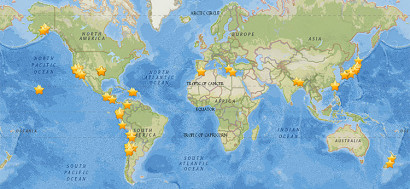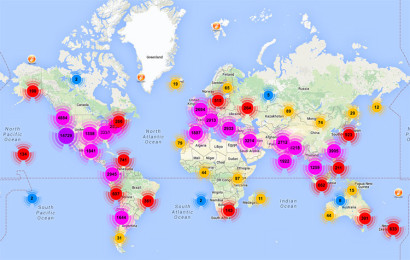Japanese-language MyShake app crowdsources earthquake shaking
Berkeley scientists hope to tap seismically active Japan to test MyShake app

May 21, 2016
UC Berkeley scientists are releasing a Japanese version of an Android app that crowdsources ground-shaking information from smartphones to detect quakes and eventually warn users of impending jolts from nearby quakes.
The app, called MyShake, will be publicly available on Sunday, May 22 (Tokyo time), through the Google Play Store, which can be accessed via the MyShake website. It runs in the background and draws little power, so that a phone’s onboard accelerometers can record local shaking any time of the day or night. For now, the app only collects information from the accelerometers, analyzes it and, if it fits the vibrational profile of a quake, relays it and the phone’s GPS coordinates to the Berkeley Seismological Laboratory in California for analysis.
Since it was first released in English on Feb. 12, 2016, more than 170,000 people have downloaded the app from around the world, and on any given day 11,000 phones provide data to the system. In these three months, the network has recorded earthquakes in Chile, Argentina, Mexico, Morocco, Nepal, New Zeland, Taiwan, Japan and across North America, including induced earthquakes in Oklahoma. The system has recorded earthquakes as small as magnitude 2.5 and as large as the April 16, 2016, magnitude 7.8 earthquake in Ecuador.

A map of the 121 earthquakes to date for which MyShake has recorded some seismic data, ranging in magnitude form 2.5 to 7.8.
Once enough people are using the app and the bugs are worked out, UC Berkeley seismologists plan to use the data to warn people miles from ground zero that shaking is rumbling their way.
“We think MyShake can make earthquake early warning faster and more accurate in areas that have a traditional seismic network, such as Japan, and can provide life-saving early warning in countries that have no seismic network,” said Richard Allen, the leader of the app project, director of the Berkeley Seismological Laboratory and a professor and chair of UC Berkeley’s Department of Earth and Planetary Sciences.
Allen will give an invited talk about the MyShake app and an early-warning system called ShakeAlert for the West Coast of the United States on Sunday morning, May 22, the opening day of the annual meeting of the Japan Geoscience Union. The meeting, held jointly with the American Geophysical Union, takes place at the Makuhari Messe convention center in Chiba, outside of Tokyo.

Of the 170,000 people who have downloaded MyShake since February, 70,000 provided location information, shown on this world map.
“In my opinion, this is cutting-edge research that will transform seismology,” said UC Berkeley graduate student Qingkai Kong, who developed the algorithm at the heart of the app. “The stations we have for traditional seismology are not that dense, especially in some regions around the world, but using smartphones with low-cost sensors will give us a really good, dense network in the future.”
Spanish and Chinese versions of the app are planned for the future, as is MyShake for the iPhone.
For more about how the app works, link to an online story and video with Japanese subtitles.
RELATED INFORMATION